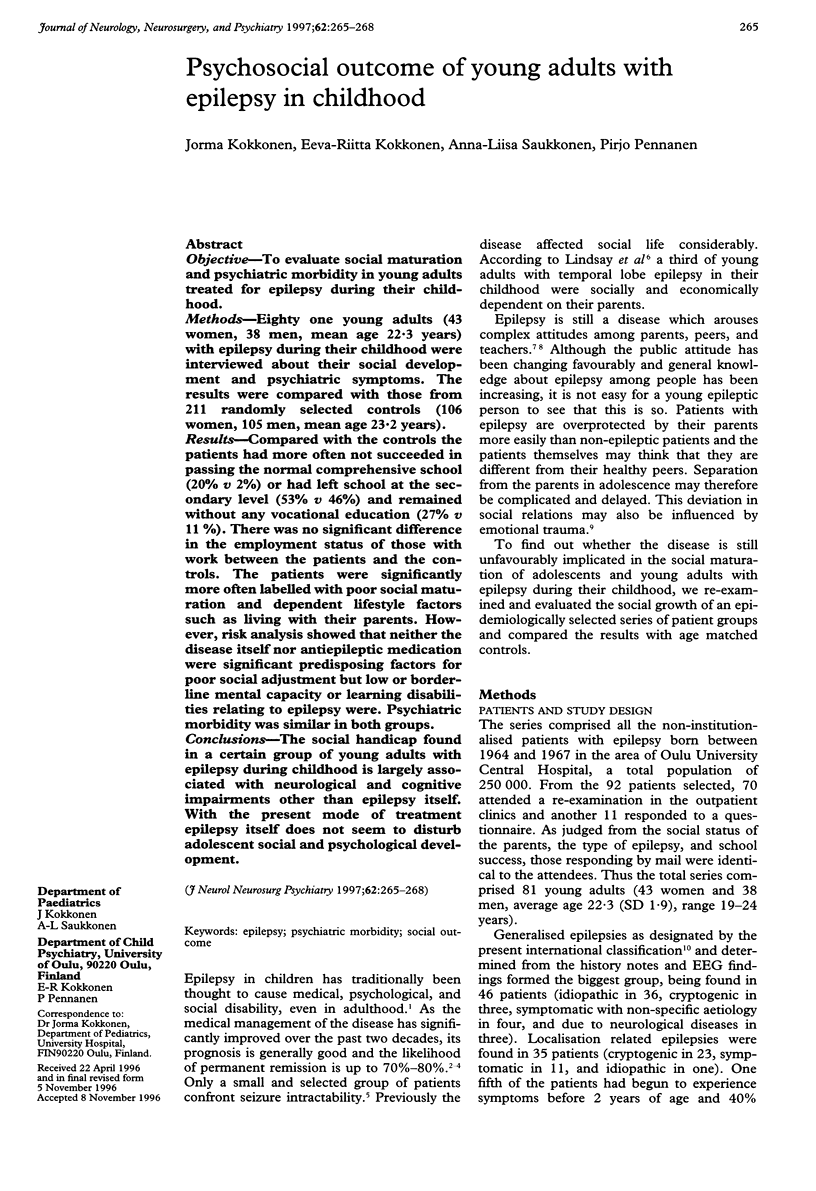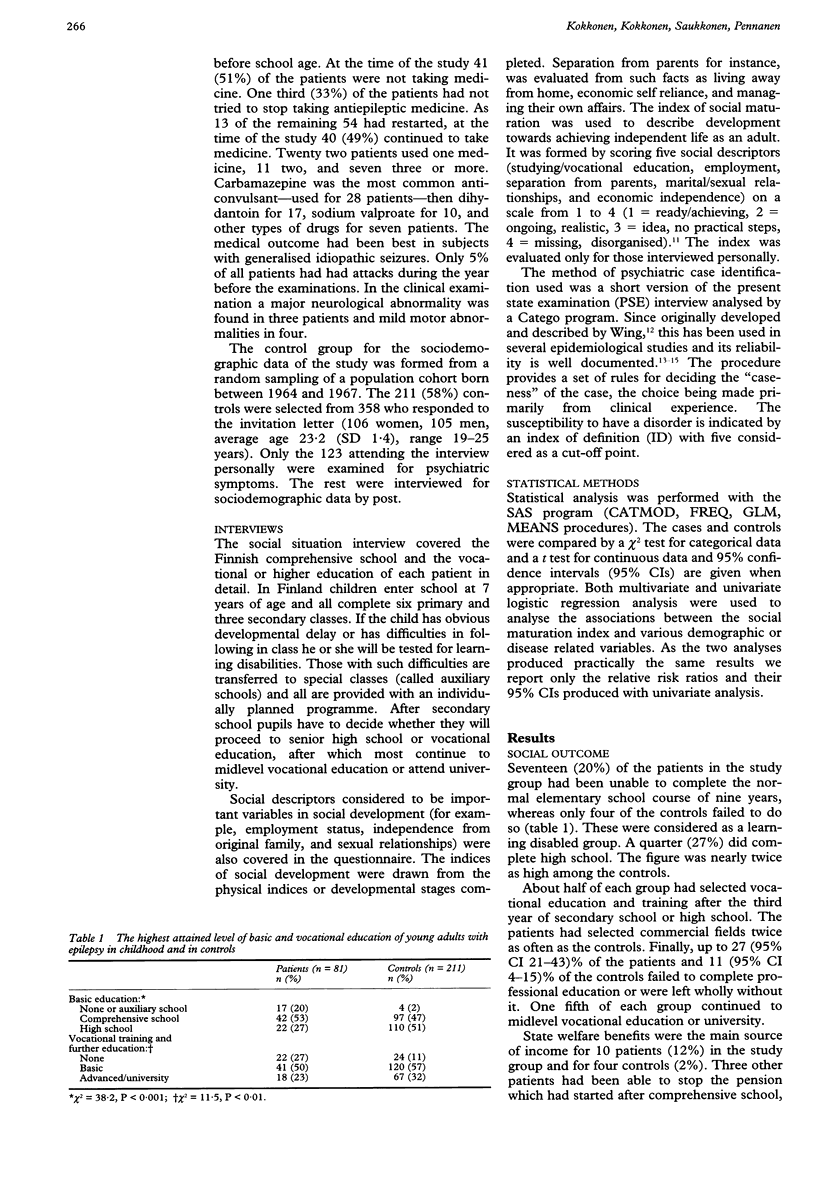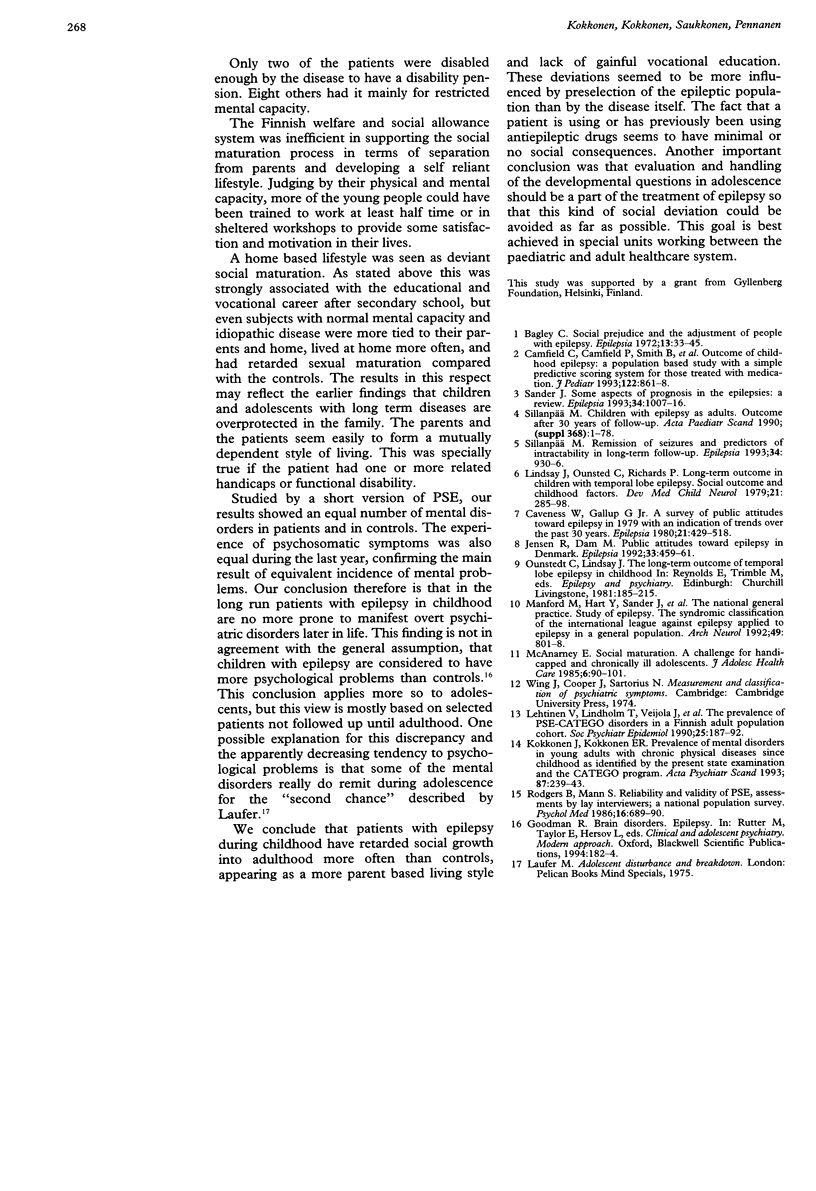Abstract
OBJECTIVE: To evaluate social maturation and psychiatric morbidity in young adults treated for epilepsy during their childhood. METHODS: Eighty one young adults (43 women, 38 men, mean age 22.3 years) with epilepsy during their childhood were interviewed about their social development and psychiatric symptoms. The results were compared with those from 211 randomly selected controls (106 women, 105 men, mean age 23.2 years). RESULTS: Compared with the controls the patients had more often not succeeded in passing the normal comprehensive school (20% v 2%) or had left school at the secondary level (53% v 46%) and remained without any vocational education (27% v 11%). There was no significant difference in the employment status of those with work between the patients and the controls. The patients were significantly more often labelled with poor social maturation and dependent lifestyle factors such as living with their parents. However, risk analysis showed that neither the disease itself nor antiepileptic medication were significant predisposing factors for poor social adjustment but low or borderline mental capacity or learning disabilities relating to epilepsy were. Psychiatric morbidity was similar in both groups. CONCLUSIONS: The social handicap found in a certain group of young adults with epilepsy during childhood is largely associated with neurological and cognitive impairments other than epilepsy itself. With the present mode of treatment epilepsy itself does not seem to disturb adolescent social and psychological development.
Full text
PDF



Selected References
These references are in PubMed. This may not be the complete list of references from this article.
- Bagley C. Social prejudice and the adjustment of people with epilepsy. Epilepsia. 1972 Jan;13(1):33–45. doi: 10.1111/j.1528-1157.1972.tb04547.x. [DOI] [PubMed] [Google Scholar]
- Camfield C., Camfield P., Gordon K., Smith B., Dooley J. Outcome of childhood epilepsy: a population-based study with a simple predictive scoring system for those treated with medication. J Pediatr. 1993 Jun;122(6):861–868. doi: 10.1016/s0022-3476(09)90008-7. [DOI] [PubMed] [Google Scholar]
- Caveness W. F., Gallup G. H., Jr A survey of public attitudes toward epilepsy in 1979 with an indication of trends over the past thirty years. Epilepsia. 1980 Oct;21(5):509–518. doi: 10.1111/j.1528-1157.1980.tb04302.x. [DOI] [PubMed] [Google Scholar]
- Jensen R., Dam M. Public attitudes toward epilepsy in Denmark. Epilepsia. 1992 May-Jun;33(3):459–463. doi: 10.1111/j.1528-1157.1992.tb01691.x. [DOI] [PubMed] [Google Scholar]
- Kokkonen J., Kokkonen E. R. Prevalence of mental disorders in young adults with chronic physical diseases since childhood as identified by the Present State Examination and the CATEGO program. Acta Psychiatr Scand. 1993 Apr;87(4):239–243. doi: 10.1111/j.1600-0447.1993.tb03365.x. [DOI] [PubMed] [Google Scholar]
- Lehtinen V., Lindholm T., Veijola J., Väisänen E. The prevalence of PSE-CATEGO disorders in a Finnish adult population cohort. Soc Psychiatry Psychiatr Epidemiol. 1990 Jul;25(4):187–192. doi: 10.1007/BF00782960. [DOI] [PubMed] [Google Scholar]
- Lindsay J., Ounsted C., Richards P. Long-term outcome in children with temporal lobe seizures. I: Social outcome and childhood factors. Dev Med Child Neurol. 1979 Jun;21(3):285–298. doi: 10.1111/j.1469-8749.1979.tb01621.x. [DOI] [PubMed] [Google Scholar]
- Manford M., Hart Y. M., Sander J. W., Shorvon S. D. The National General Practice Study of Epilepsy. The syndromic classification of the International League Against Epilepsy applied to epilepsy in a general population. Arch Neurol. 1992 Aug;49(8):801–808. doi: 10.1001/archneur.1992.00530320025008. [DOI] [PubMed] [Google Scholar]
- Rodgers B., Mann S. A. The reliability and validity of PSE assessments by lay interviewers: a national population survey. Psychol Med. 1986 Aug;16(3):689–700. doi: 10.1017/s0033291700010436. [DOI] [PubMed] [Google Scholar]
- Sander J. W. Some aspects of prognosis in the epilepsies: a review. Epilepsia. 1993 Nov-Dec;34(6):1007–1016. doi: 10.1111/j.1528-1157.1993.tb02126.x. [DOI] [PubMed] [Google Scholar]
- Sillanpä M. Children with epilepsy as adults: outcome after 30 years of follow-up. Acta Paediatr Scand Suppl. 1990;368:1–78. [PubMed] [Google Scholar]
- Sillanpä M. Remission of seizures and predictors of intractability in long-term follow-up. Epilepsia. 1993 Sep-Oct;34(5):930–936. doi: 10.1111/j.1528-1157.1993.tb02114.x. [DOI] [PubMed] [Google Scholar]


